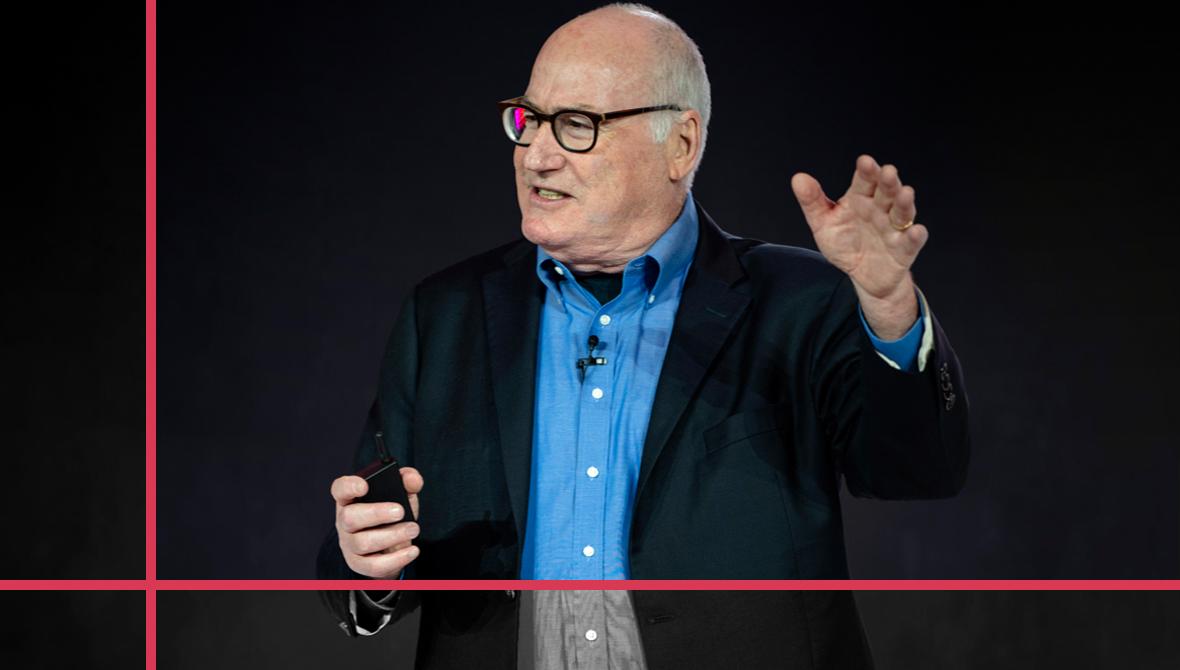Jargon monoxide, friction fixers, and the meeting that could have been an email
Organizational psychologist and best-selling author Robert Sutton discusses companies’ obstacles and catalysts for getting things done.

Robert Sutton is a special kind of academic. The Stanford University emeritus professor conducts rigorous research, but his audience isn’t other professors—it’s executives, managers, and just about anyone else who works at a company.
Throughout his more than 40 years as an organizational psychologist, Sutton has studied the problem of organizational dysfunction and worked to come up with solutions, which he has shared in some of his best-selling books, including The Asshole Survival Guide and Scaling Up Excellence. The Friction Project: How Smart Leaders Make the Right Things Easier and the Wrong Things Harder is his most recent offering, coauthored with his longtime Stanford University collaborator, Huggy Rao. The book challenges leaders to think hard about friction—the processes and behaviors that make it more difficult or even impossible to get things done at organizations—and how “good friction” can be applied to everything from improving workplace efficiency to executing large-scale business reinvention.
In our recent interview with Sutton, he discussed what good friction in organizations looks like, and some of the cultural behavioral traps that leaders should avoid. What follows is an edited version of our conversation.
S+B: What did you and Huggy Rao set out to explore in The Friction Project?
SUTTON: We started the project because there were so many people in so many organizations that we worked with—even wonderfully successful organizations—who were frustrated about how hard it was to get simple things done. And honestly, if you’re working with a group of executives, a great way to warm them up is to ask them about what’s driving them crazy. So, we did have a lot of, if you will, negative energy problems that fueled [the project]. That’s the bad news. But during the seven or eight years that we worked on this project, the good news was, we discovered a whole bunch of ways that smart leaders and teams made things better for others and for themselves [by deliberately introducing friction into certain processes]. So, we got interested in good friction, too.
S+B: What does good friction look like?
SUTTON: Probably my favorite example is, there’s a guy named Laszlo Bock. Laszlo was Head of People Operations (essentially HR) at Google for about eight years, and when he got to Google, there was a culture, a behavioral expectation that before you gave somebody a job offer, you would interview them eight, 12, 15 times.
And when we did fact-checking with Laszlo, he said it was as many as 25 times before they were given an offer. Think about all the scheduling that would require, all the weight and annoyance it would put on candidates. This was a big source of friction, and it was a cultural tradition that made sense in the very early days, when [Google cofounders] Larry [Page] and Sergey [Brin] were trying to hire the perfect first 200 or so people, but it continued [well past that].
So, what Laszlo did was he put in a simple rule, which I would call good friction, which was, if you are going to do more than four interviews before making a decision about hiring a candidate, you have to get written permission from me, an executive vice president. And the number of interviews dropped quite considerably after that.
S+B: On the flip side, how do you think “bad friction” influences the culture of an organization? Can culture help counteract friction?
SUTTON: To me, culture is essentially the expectations about behavior in an organization that people hold for themselves and hold others responsible for.
And let’s just talk about two of the key impediments that cause bad friction in organizations. One is “addition sickness.” This is the notion that we as human beings are wired to solve problems by making things more and more complex. A friend of mine, Michael Dearing, now a venture capitalist and senior executive at quite a few companies, says that in cultures where people reduce bad friction, people think and act like editors in chief. Good editors are constantly trying to make messages concise and clear, and also make actions as clear as possible. And so that’s one aspect of cultural behavioral standards.
Another element is unnecessary friction, in coordination and collaboration. In large, complex organizations, there are lots of silos and therefore lots of handoffs between different teams and departments. Handoffs are important. Dysfunctional conflict arises when people in those different teams or departments see each other as enemies. It then becomes really difficult for them to collaborate. It’s a cultural behavioral trap that leaders need to watch out for.
“When you are at the top of an organization, you can unwittingly waste an enormous amount of time.”
Length: 0:29 seconds
S+B: What is a common source of friction that you’ve seen across most organizations?
SUTTON: One of the things that I’ve been obsessed with for years is the notion of “jargon monoxide”—that is, people in organizations often use language that, well, means nothing. It’s sort of BS. It’s so complicated nobody can understand what they’re talking about. And people use different language in different silos. That undermines communication—both with clients and across the organization.
Right now, in medicine, there are a number of efforts to improve the quality of communication with patients. The largest healthcare system in Rhode Island put their surgical consent form through ChatGPT, and they said, “Make it as simple as possible.” And they cut it by about 50% and got rid of all this medical jargon. That’s now the surgical consent form that’s being used in the largest healthcare system in Rhode Island. So, to me, that’s a great example of subtraction and cleaning up the jargon monoxide, too.
S+B: In terms of unnecessary complexity, what would you say is harming organizations the most?
SUTTON: If I were going to pick one example, it would be administrative bloat. Yes, in government, but in big companies, too. In so many organizations, when a manager has more people reporting to him or her, they get paid more. So, literally, we have incentives for people building larger and larger fiefdoms. And I would say to leaders, “Do you unknowingly have incentives in your organization for people to add complexity, and maybe even punish people who don’t play that game?”
S+B: You write in the book about “friction fixers” in organizations. Who do these people tend to be?
SUTTON: In the best organizations, I think that everybody sees themselves as responsible and accountable for easing the load on other people as much as possible. To me, a good friction fixer is, first of all, somebody who understands how the work itself is done. And second of all, they’re dedicated not just to reducing bad friction for themselves, but training their teams and encouraging them to think that way.
So, when I visited the California Department of Motor Vehicles, I got there at 7:30 in the morning. There were 60 people in line in front of me. I thought I was going to be there all day. Then this amazing friction fixer started walking down the line at 7:40 asking each one of us why we were there. And if we needed a form, he gave us forms.
Some people were there for something they couldn’t do at the motor vehicle department, like get a passport. It was suggested that there was no reason for them to be [there]. He gave me my form, he told me what window to go to, and I was out of there by 8:15. And I was just in a state of shock, because I had this friction fixer who was like a tour guide. So now, we’re in conversation with the person who would be his boss, a government appointee in charge of the entire California Department of Motor Vehicles. And using technology, culture, training, and process analysis, they’re trying to figure out how to reduce burdens on everyone.
S+B: Let’s shift gears and talk about the role of friction—good and bad—when organizations are seriously transforming or reinventing themselves.
SUTTON: Well, where I would start—and this is straight out of the Jeff Bezos playbook—is [asking], are the changes reversible or irreversible? If there are things that are easily reversible and aren’t going to kill your company if you abandon them, then go ahead and do it. But if you are making a bet that’s so big that it’s going to kill or hobble your company, you’ve got to slow down and really do that heavy analysis—and good friction is absolutely necessary here.
I’ll give you another example. Years ago, when the web was relatively new, I was working with a startup, and initially the way that they made money was by consulting and helping other firms create good new websites. But that business evaporated. They brought in a new CEO, and their only hope of surviving was to just develop one product—instead of helping other people create websites, they were creating their own single web-based product. When anybody tried to do anything the old way and cheat on the side and do a little bit of consulting, the very sharp CEO would just cut off their budgets immediately.
They ended up selling the company to another large company, and it saved the entire thing, this discipline of making it absolutely impossible to do things from the old business model. That was one of the more impressive turnarounds I’ve seen.
“When you see somebody who is upset, it’s a design problem and a business opportunity.”
Length: 0:25 seconds
S+B: Let’s look ahead now. What’s next for you?
SUTTON: One of the main things that I’m doing is working with a bunch of organizations, especially on friction-fixing stuff. And just like everybody else, initially I resisted, but now I’m getting pretty interested in artificial intelligence both as a solution to removing unnecessary friction in organizations and as a potential risk. One of the things that I’m worried about with a lot of these large language models is, is this actually a more efficient way to add burdens on other people? It’s a more efficient way, really, for bureaucrats, lawyers, and other people to create red tape than they have [used] in the past. So that’s something that we’ve got to guard against.
S+B: After all the work you’ve done in this area, are you an optimist or a pessimist about the ability of leaders to create organizations that are effective, provide positive work experiences, and enrich their employees?
SUTTON: Taking on this challenge of organizational friction started with pessimism, but over the years, Huggy and I have kept finding more and more people who actually find business solutions to make things better. And so, even though I’m not a naturally optimistic person, I’m becoming more and more optimistic.
A quick example: I did some work with one of my former students, who was a research assistant on this entire project, and who now works at [software company] Asana and runs something called the Work Innovation Lab there. We came up with an intervention for 60 Asana employees in which they evaluated each standing meeting they had in terms of how important it was and how much work it was. And they identified a bunch of meetings that weren’t very important but were a lot of work, and we worked with them to get rid of some and to make others shorter.
Because of this, the average employee saved about four hours a month. That’s a subtraction mindset—but it’s also the optimistic mindset, that these employees weren’t just victims of the meetings they were part of. They could actually do something to make their lives better. And I don’t know about you, but getting back four hours a month, that sounds pretty good to me.




